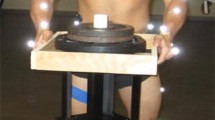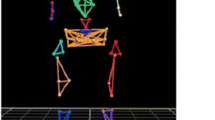Abstract
Preventative and rehabilitative efforts relative to low back pain (LBP) and manual material handling (MMH) are often directed toward proper technique. However, breath control may be an additional factor to consider. Optimizing breath control may provide increased segmental control of the spine through the production of increased intra-abdominal pressure. It has been found that breath control differs during the lifting phase of MMH for individuals with LBP. However, little is known about breath control during the lowering portion even though it accounts for 30% of MMH tasks. In this study, individuals with LBP (n = 32) and aged-matched healthy individuals (n = 30) lowered a crate from a table to the floor four times with the crate empty and four times with the crate loaded at 25% of body weight. The amount of volume in the lungs as a percentage of each individual’s vital capacity (VC) was identified at nine points during the lowering task. Individuals with LBP completed the lowering task with significantly more volume in their lungs (45.9% VC) than healthy peers (40.9% VC). Further, with increasing age %VC significantly increased in those with LBP. Moreover, %VC significantly increased in response to the mechanical challenges introduced when lowering a load. These findings support the theoretical link between breath control and lumbar segmental control and provide preliminary evidence supporting rehabilitative efforts which add a focus on breath control for those with LBP.



Similar content being viewed by others
References
Baecke JA, Burema J, Frijters JE (1982) A short questionnaire for the measurement of habitual physical activity in epidemiological studies. Am J Clin Nutr 36:936–942
Balldin UI, Myhre K, Tesch PA, Wilhelmsen U, Andersen HT (1985) Isometric abdominal muscle training and G tolerance. Aviat Space Environ Med 56:120–124
Cholewicki J, McGill SM (1992) Lumbar posterior ligament involvement during extremely heavy lifts estimated from fluoroscopic measurements. J Biomech 25:17–28
Cholewicki J, McGill SM (1996) Mechanical stability of the in vivo lumbar spine: implications for injury and chronic low back pain. Clin Biomech (Bristol, Avon) 11:1–15
Cholewicki J, Juluru K, Radebold A, Panjabi MM, McGill SM (1999) Lumbar spine stability can be augmented with an abdominal belt and/or increased intra-abdominal pressure. Eur Spine J 8:388–395
Cole MH, Grimshaw PN (2003) Low back pain and lifting: a review of epidemiology and aetiology. Work (Reading Mass) 21:173–184
Cresswell AG, Thorstensson A (1994) Changes in intra-abdominal pressure, trunk muscle activation and force during isokinetic lifting and lowering. Eur J Appl Physiol Occup Physiol 68:315–321
Cresswell AG, Grundstrom H, Thorstensson A (1992) Observations on intra-abdominal pressure and patterns of abdominal intra-muscular activity in man. Acta Physiol Scand 144:409–418
Cresswell AG, Oddsson L, Thorstensson A (1994) The influence of sudden perturbations on trunk muscle activity and intra-abdominal pressure while standing. Exp Brain Res 98:336–341
Ekstrom L, Kaigle A, Hult E, Holm S, Rostedt M, Hansson T (1996) Intervertebral disc response to cyclic loading–an animal model. Proc Inst Mech Eng [H] 210:249–258
Essendrop M, Andersen TB, Schibye B (2002) Increase in spinal stability obtained at levels of intra-abdominal pressure and back muscle activity realistic to work situations. Appl Ergon 33:471–476
Fairbank JC, Couper J, Davies JB, O’Brien JP (1980) The oswestry low back pain disability questionnaire. Physiotherapy 66:271–273
Goldish GD, Quast JE, Blow JJ, Kuskowski MA (1994) Postural effects on intra-abdominal pressure during Valsalva maneuver. Arch Phys Med Rehabil 75:324–327
Hagins M, Lamberg EM (2011) Individuals with low back pain breathe differently than healthy individuals during a lifting task. J Orthop Sports Phys Ther 41:141–148
Hagins M, Pietrek M, Sheikhzadeh A, Nordin M, Axen K (2004) The effects of breath control on intra-abdominal pressure during lifting tasks. Spine 29:464–469
Hagins M, Pietrek M, Sheikhzadeh A, Nordin M (2006) The effects of breath control on maximum force and IAP during a maximum isometric lifting task. Clin Biomech (Bristol, Avon) 21:775–780
Harman EA, Frykman PN, Clagett ER, Kraemer WJ (1988) Intra-abdominal and intra-thoracic pressures during lifting and jum**. Med Sci Sports Exerc 20:195–201
Hodges PW, Eriksson AE, Shirley D, Gandevia SC (2005) Intra-abdominal pressure increases stiffness of the lumbar spine. J Biomech 38:1873–1880
Iatridis JC, Setton LA, Foster RJ, Rawlins BA, Weidenbaum M, Mow VC (1998) Degeneration affects the anisotropic and nonlinear behaviors of human anulus fibrosus in compression. J Biomech 31:535–544
Jacobs DR Jr, Ainsworth BE, Hartman TJ, Leon AS (1993) A simultaneous evaluation of 10 commonly used physical activity questionnaires. Med Sci Sports Exerc 25:81–91
Lamberg EM, Hagins M (2010) Breath control during manual free-style lifting of a maximally tolerated load. Ergonomics 53:385–392
Loscher WN, Cresswell AG, Thorstensson A (1994) Electromyographic responses of the human triceps surae and force tremor during sustained submaximal isometric plantar flexion. Acta Physiol Scand 152:73–82
McGill SM, Norman RW (1985) Dynamically and statically determined low back moments during lifting. J Biomech 18:877–885
McGill SM, Norman RW (1988) Potential of lumbodorsal fascia forces to generate back extension moments during squat lifts. J Biomed Eng 10:312–318
Mcgill S, Sharratt MT (1990) Relationship between intra-abdominal pressure and trunk EMG. Clin Biomech 5:59–67
McGill SM, Norman RW, Sharratt MT (1990) The effect of an abdominal belt on trunk muscle activity and intra-abdominal pressure during squat lifts. Ergonomics 33:147–160
McGill S, Seguin J, Bennett G (1994) Passive stiffness of the lumbar torso in flexion, extension, lateral bending, and axial rotation. Effect of belt wearing and breath holding. Spine 19:696–704
NIOSH (1981) A work practices guideline for manual lifting: technical report, No 81–122. USDoHaH
Panjabi MM (1992) The stabilizing system of the spine. Part II. Neutral zone and instability hypothesis. J Spinal Disord 5:390–396 (discussion 397)
Philippaerts RM, Westerterp KR, Lefevre J (1999) Doubly labelled water validation of three physical activity questionnaires. Int J Sports Med 20:284–289
Pols MA, Peeters PH, Bueno-De-Mesquita HB, Ocke MC, Wentink CA, Kemper HC, Collette HJ (1995) Validity and repeatability of a modified Baecke questionnaire on physical activity. Int J Epidemiol 24:381–388
Shirley D, Hodges PW, Eriksson AE, Gandevia SC (2003) Spinal stiffness changes throughout the respiratory cycle. J Appl Physiol 95:1467–1475
Toussaint HM, Commissaris DA, Hoozemans MJ, Ober MJ, Beek PJ (1997) Anticipatory postural adjustments before load pickup in a bi-manual whole body lifting task. Med Sci Sports Exerc 29:1208–1215
Wedin S, Leanderson R, Knutsson E (1988) The effect of voluntary diaphragmatic activation on back lifting. Scand J Rehabil Med 20:129–132
Acknowledgments
This work was supported by a National Institute of General Medical Sciences: Minority Biomedical Research Support, Support of Continuous Research Excellence, Grant 1S06 GM074923-01.
Conflict of interest
The authors have no conflict of interest to declare.
Author information
Authors and Affiliations
Corresponding author
Additional information
Communicated by Susan A. Ward.
E. M. Lamberg and M. Hagins contributed equally to the design and implementation of this study.
Rights and permissions
About this article
Cite this article
Lamberg, E.M., Hagins, M. The effects of low back pain on natural breath control during a lowering task. Eur J Appl Physiol 112, 3519–3524 (2012). https://doi.org/10.1007/s00421-012-2328-6
Received:
Accepted:
Published:
Issue Date:
DOI: https://doi.org/10.1007/s00421-012-2328-6




